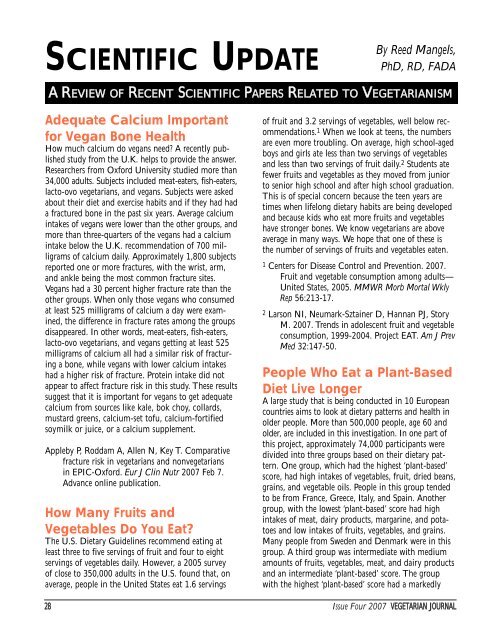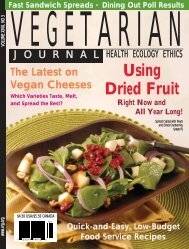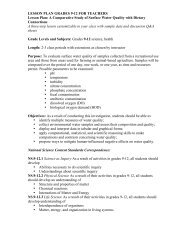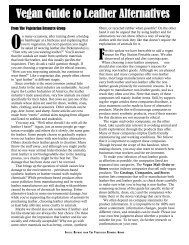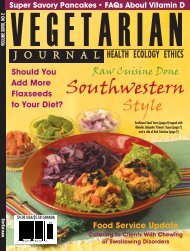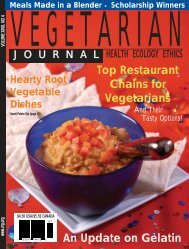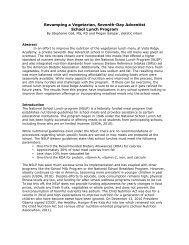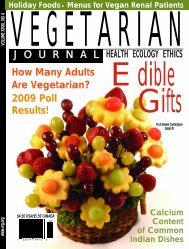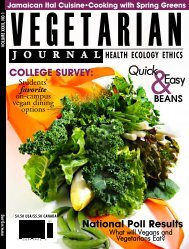Is Your Sugar Vegan? - The Vegetarian Resource Group
Is Your Sugar Vegan? - The Vegetarian Resource Group
Is Your Sugar Vegan? - The Vegetarian Resource Group
You also want an ePaper? Increase the reach of your titles
YUMPU automatically turns print PDFs into web optimized ePapers that Google loves.
SCIENTIFIC UPDATE<br />
By Reed Mangels,<br />
PhD, RD, FADA<br />
A REVIEW OF RECENT SCIENTIFIC PAPERS RELATED TO VEGETARIANISM<br />
Adequate Calcium Important<br />
for <strong>Vegan</strong> Bone Health<br />
How much calcium do vegans need A recently published<br />
study from the U.K. helps to provide the answer.<br />
Researchers from Oxford University studied more than<br />
34,000 adults. Subjects included meat-eaters, fish-eaters,<br />
lacto-ovo vegetarians, and vegans. Subjects were asked<br />
about their diet and exercise habits and if they had had<br />
a fractured bone in the past six years. Average calcium<br />
intakes of vegans were lower than the other groups, and<br />
more than three-quarters of the vegans had a calcium<br />
intake below the U.K. recommendation of 700 milligrams<br />
of calcium daily. Approximately 1,800 subjects<br />
reported one or more fractures, with the wrist, arm,<br />
and ankle being the most common fracture sites.<br />
<strong>Vegan</strong>s had a 30 percent higher fracture rate than the<br />
other groups. When only those vegans who consumed<br />
at least 525 milligrams of calcium a day were examined,<br />
the difference in fracture rates among the groups<br />
disappeared. In other words, meat-eaters, fish-eaters,<br />
lacto-ovo vegetarians, and vegans getting at least 525<br />
milligrams of calcium all had a similar risk of fracturing<br />
a bone, while vegans with lower calcium intakes<br />
had a higher risk of fracture. Protein intake did not<br />
appear to affect fracture risk in this study. <strong>The</strong>se results<br />
suggest that it is important for vegans to get adequate<br />
calcium from sources like kale, bok choy, collards,<br />
mustard greens, calcium-set tofu, calcium-fortified<br />
soymilk or juice, or a calcium supplement.<br />
Appleby P, Roddam A, Allen N, Key T. Comparative<br />
fracture risk in vegetarians and nonvegetarians<br />
in EPIC-Oxford. Eur J Clin Nutr 2007 Feb 7.<br />
Advance online publication.<br />
How Many Fruits and<br />
Vegetables Do You Eat<br />
<strong>The</strong> U.S. Dietary Guidelines recommend eating at<br />
least three to five servings of fruit and four to eight<br />
servings of vegetables daily. However, a 2005 survey<br />
of close to 350,000 adults in the U.S. found that, on<br />
average, people in the United States eat 1.6 servings<br />
of fruit and 3.2 servings of vegetables, well below recommendations.<br />
1 When we look at teens, the numbers<br />
are even more troubling. On average, high school-aged<br />
boys and girls ate less than two servings of vegetables<br />
and less than two servings of fruit daily. 2 Students ate<br />
fewer fruits and vegetables as they moved from junior<br />
to senior high school and after high school graduation.<br />
This is of special concern because the teen years are<br />
times when lifelong dietary habits are being developed<br />
and because kids who eat more fruits and vegetables<br />
have stronger bones. We know vegetarians are above<br />
average in many ways. We hope that one of these is<br />
the number of servings of fruits and vegetables eaten.<br />
1 Centers for Disease Control and Prevention. 2007.<br />
Fruit and vegetable consumption among adults—<br />
United States, 2005. MMWR Morb Mortal Wkly<br />
Rep 56:213-17.<br />
2 Larson NI, Neumark-Sztainer D, Hannan PJ, Story<br />
M. 2007. Trends in adolescent fruit and vegetable<br />
consumption, 1999-2004. Project EAT. Am J Prev<br />
Med 32:147-50.<br />
People Who Eat a Plant-Based<br />
Diet Live Longer<br />
A large study that is being conducted in 10 European<br />
countries aims to look at dietary patterns and health in<br />
older people. More than 500,000 people, age 60 and<br />
older, are included in this investigation. In one part of<br />
this project, approximately 74,000 participants were<br />
divided into three groups based on their dietary pattern.<br />
One group, which had the highest ‘plant-based’<br />
score, had high intakes of vegetables, fruit, dried beans,<br />
grains, and vegetable oils. People in this group tended<br />
to be from France, Greece, Italy, and Spain. Another<br />
group, with the lowest ‘plant-based’ score had high<br />
intakes of meat, dairy products, margarine, and potatoes<br />
and low intakes of fruits, vegetables, and grains.<br />
Many people from Sweden and Denmark were in this<br />
group. A third group was intermediate with medium<br />
amounts of fruits, vegetables, meat, and dairy products<br />
and an intermediate ‘plant-based’ score. <strong>The</strong> group<br />
with the highest ‘plant-based’ score had a markedly<br />
28 <strong>Is</strong>sue Four 2007 VEGETARIAN JOURNAL


